|
Deborah L. Thompson As any early educator will attest, children love science. Worms, insects, seeds, weeds, rocks, and other natural objects make their way to classrooms via the hands, pockets and bookbags of budding young scientists, often providing teachers with topics for teachable moments. As the books reviewed in this column reflect, STEM topics are everywhere, whether in a story of a young child and her father taking a hike up a mountain, herds of animals migrating on the Serengeti, or scientists reintroducing wolves to the nation’s most remote national park, Isle Royale. 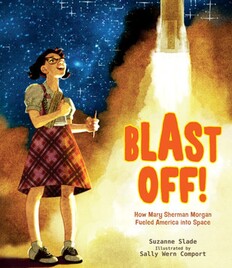 Blast Off! How Mary Sherman Morgan Fueled America into Space. Suzanne Slade. Illus. by Sally Wern Comport. (2022). Calkins Creek. Suzanne Slade introduces readers to Mary Sherman Morgan (1921-2004) in her fictional biography of this underacknowledged scientist. Mary’s early life in North Dakota was a struggle. Her parents refused to send her to school because there were too many chores for her on the family farm. She finally began school at age eight (with the aid of a social worker and the county sheriff), and after graduating from high school, she worked and earned enough money to study chemistry in college for two years. World War II gave Mary the break she needed to work in a lab manufacturing explosives. Hired by North American Aviation at the end of the war, Mary experimented tirelessly and created hydyne, the fuel that powered America’s earliest rockets into space. Sally Wern Comport’s mixed-media artwork with clever overlays of mathematical and scientific symbols on selected pages of the biography adds to the feel of excitement about science in the 20th century. Back matter includes a chronology, selected bibliography, an author’s note, and archival images. (Gr 3 Up) 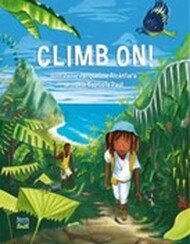 Climb On! Baptiste Paul. Illus. by Jacqueline Alcántara. (2022). NorthSouth. A young girl eagerly anticipates a day’s hike to the “tippy top” of the local mountain. Although her dad had planned a day of looking at fútbol on television, he agrees to the hike. With their backpacks filled with snacks, water and a first aid kit, they enter the forest and begin their climb. They encounter swarms of insects and observe an array of flora (bird of paradise, hibiscus, vines, and other tropical plants) and fauna (colorful birds, iguanas, caterpillars, other small animals) as they make their strenuous trek. Once they reach the summit, father and daughter look down at their town— “a mosaic masterpiece” of colorful houses by the sea. Baptiste Paul’s rhythmic text with onomatopoeia (“Buzz, buzz, buzz. / Smack, smack, smack!”) and Creole terms (“Mouté. Climb on” and “Anlé, anlé, anlé. Up, up, up.”) is complemented by Jacqueline Alcántara’s richly detailed illustrations. The scene on the back endpaper provides achallenge—"Did you see these creatures? What else did you see?”—that invites the rereading of this adventure story. (PreK-Gr 2) 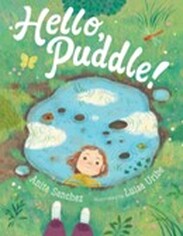 Hello, Puddle! Anita Sanchez. Illus. by Luisa Uribe. (2022). Clarion. “Hello, puddle! Who’s here?” asks a young girl. The puddle supports a thriving ecosystem that changes with the seasons. In spring, toads lay eggs in the water and the puddle is soon filled with tadpoles and toadlets. Seedlings of grasses, wildflowers, and trees sprout, and a mother turtle digs holes and lays her eggs in the moist soil around the puddle. In summer, ducks and their ducklings, mosquitoes, snails, mud daubers, and other creatures make their appearance. As summer heats up, the puddle shrinks to just a few wet spots until rain makes it perfect for puddling by butterflies that suck nutrients from the moist soil. In fall, deer may drink from the puddle, and then winter rushes in to freeze it. “Goodbye, puddle. See you in the spring!” Luisa Uribe’s colorful, digital illustrations realistically evoke the changing seasons. Back matter includes an author’s note, information on how to make a puddle and observe wildlife, a chart of the “puddle lovers” in the book with their common and scientific names and brief descriptions, a glossary, a “Learn More” list of books and websites, and a bibliography. (PreK-Gr 2) 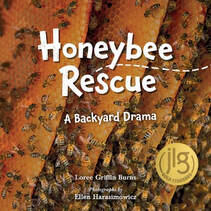 Honeybee Rescue: A Backyard Drama. Loree Griffin Burns. Photographs by Ellen Harasimowicz. (2022). Charlesbridge. The author and photographer of The Hive Detectives: Chronicles of a Honey Bee Catastrophe (2010) team up to create another intriguing book about honeybees. Mr. Connery has a problem. His barn is buzzing. Some of his honeybees have swarmed from their overcrowded hive box and started a new colony in an old barn with a leaky roof and no protection from harsh weather. What does he do? Why call in a bee rescuer, of course. Mr. Nelson, a certified bee rescuer, surveys the new bee colony and then brings out his secret weapon—a bee vacuum cleaner he designed to suck up bees without harming them. The bees are safely ensconced in the vacuum until every wax comb has been transferred into a new hive box. Once the combs have been secured, Mr. Nelson gently releases the bees from the vacuum into the box. The bees quickly adapt to the new hive, and another bee rescue has ended successfully. Back matter includes an interview with bee rescuer Jon Nelson, a glossary, an author’s note, and books for further reading. (PreK Up)  The Longest Journey: An Arctic Tern’s Migration. Amy Hevron. (2022). Neal Porter. With a simple, lyrical text and beautifully crafted illustrations rendered in acrylics and pencil on wood and digitally collaged, Amy Hevron tells the story of an arctic tern’s migration—"the longest migration of any living creature on Earth”—a 60,000 miles round trip between the North Pole and South Pole. The tern begins her first journey from her birthplace in Greenland in mid-August (Hevron includes locations and dates on several segments of the little tern and her flock’s trek). After feasting on krill and small fish in the mid-Atlantic, the terns cross over the Azores in mid-September and take a rest stop in the Canary Islands. They then fskirt the coast of Africa, take a break at the Cape of Good Hope, and reach the end of their migration at Antarctica’s Weddell Sea in late November. There the little tern will rest, molt, and recover until the fall equinox in March (Southern Hemisphere seasons are opposite from the Northern Hemisphere), when she will return to her birthplace in Greenland with a flock of about 20 terns. Back matter includes more about arctic terns, further reading, and a bibliography. (Gr 3 Up) 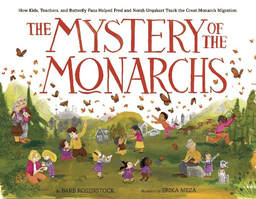 The Mystery of the Monarchs: How Kids, Teachers, and Butterfly Fans Helped Fred and Norah Urquhart Track the Great Monarch Migration. Barb Rosenstock. Illus. by Erika Meza. (2022). Knopf. Canadian Fred Urquhart (1911-2002) loved insects, especially monarch butterflies. After becoming an entomologist, Fred focused on answering the “buggy” question of where monarch butterflies go in fall. He enlisted the help of his wife, teachers, students, and other volunteers in tracking the butterflies’ migration. They tagged thousands of monarchs’ wings (Erika Meza does an excellent job illustrating the fragility of a monarch’s wings). People began sending him tagged monarchs from all over North America, but the question of where the butterfly wintered remained unanswered until January 2, 1975, when two of Fred’s volunteers discovered millions of monarchs hanging onto tree limbs “like orange leaves” high in the mountains west of Mexico City. In 1976, Fred and Norah climbed to the summit to view the monarchs. Fred noticed one butterfly that had a tagged wing—it was one of his tags. After almost 50 years of searching, he had finally answered his childhood question about where the monarchs go in the fall. Back matter includes information on the monarch butterfly, a map featuring its migration patterns, and a list for further reading. (PreK Up) 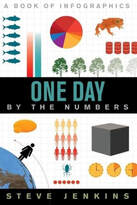 One Day: By the Numbers (By the Numbers). Steve Jenkins. (2022). Clarion. Steve Jenkins delivers to inquisitive readers a myriad of facts and figures focusing on what happens in our world in 24 hours. His meticulous research gives the reader such gems as humans travel 1,600,000 miles every 24 hours as planet Earth orbits the sun, or that we are second only to mosquitoes in killing people (1,300/day for humans and 2,500/day for mosquitoes). Jenkins fills the book with intriguing infographics (charts, graphs, diagrams), illustrations, and easy-to-understand explanatory text such as comparing the world’s daily trash production to a ten-story building (the trash dwarfs the ten-story building) or the daily per capita consumption of fresh water in different countries (the United States-1,009 gallons, China-308 gallons, and India-446 gallons). The book’s nonlinear format gives readers the choice to skip about within the book or to read it from beginning to end. The book features several reading tools: a table of contents, pagination, a glossary, and a bibliography. (PreK Up) 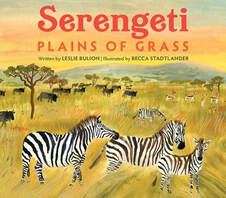 Serengeti: Plains of Grass. Leslie Bulion. Illus.by Becca Stadtlander. (2022). Peachtree. Leslie Bulion’s interconnected verses and explanatory text (in smaller print) and Becca Stadtlander’s colorful, realistic gouache-and-pastel illustrations make this beautiful book an exciting exploration of one of the world's most spellbinding ecosystems—the Serengeti. Bulion calls it “an ecosystem in motion.” In early spring, large herds of wildebeests, zebras, gazelles, and other hoofed herbivores begin their northward migration seeking life-sustaining grasses and plants. Along their route, the herds pass giraffes, elephants, butterflies and grasshoppers, flowering plants, deadly mamba snakes, and tall clay-and-sand termite mounds. Cheetahs slink in the tall grasses waiting to pounce on the young or the weak among the migrating herds. Jackals, vultures, and hyenas scavenge the carrion. Animal scat makes a tasty meal for the dung beetle and a place to lay its eggs. By late spring, the migrating animals move westward seeking greener pastures before reaching the wooded hills in the north. As the seasons change, the herds venture back to the southern Serengeti before beginning the northward cycle again. Back matter includes Bulion’s explanation of her linked “half-rhyme” quatrains based on the utendi (a Swahili poetic form), a glossary, information on various Serengeti conservation projects, further reading, and a map. (Gr 3 Up)  The Wolves and Moose of Isle Royale: Restoring an Island Ecosystem (Scientists in the Field). Nancy F. Castaldo. Photographs by Morgan Heim. (2022). Clarion. One would think that with their dastardly literary reputations in folk tales, wolves would be invincible, but they are not. Wolves are endangered and vulnerable species. Such is the case of the wolves on Isle Royale, an isolated national park located on islands on Lake Superior. Illnesses and other factors have decimated the wolf population on Isle Royale, allowing the moose population to grow out of control. Too many moose devour and trample the plants necessary for other island animals to survive. In another outstanding addition to the Scientists-in-the-Field series, Nancy F. Castaldo and Morgan Heim focus on this potential disaster by examining the attempt to reintroduce wolves to Isle Royale. They shadow the scientists and their support staff observing how well the reintroduction of wolves is progressing. It is not yet time to celebrate because the wolf-moose balance is still out of sync. Only time and the challenging work of scientists will determine if the rewilding of wolves on Isle Royale is successful in restoring the island ecosystem. Back matter includes an FYI page, source notes, glossary, and index. (Gr 3 Up) Deborah L. Thompson is a Professor Emeritus at The College of New Jersey.
0 Comments
Sandip Wilson Books on historical topics in fiction and nonfiction provide insight into human experience while they give details on lives and events in the past. The books reviewed here share stories about events that may be new for readers and offer new perspectives on events that might be familiar. 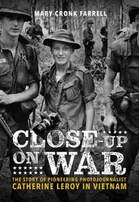 Close-up on War: The Story of Pioneering Photojournalist Catherine Leroy in Vietnam. Mary Cronk Farrell. (2022). Amulet. Showing resourcefulness and courage, French-born Catherine Leroy (1944-2006) became a well-known photojournalist at a time when the profession was dominated by men. Mary Cronk Farrell chronicles the work of Leroy (the only woman photographer in Vietnam from 1966-1969) while embedded with the U.S. Marines, who had growing respect for this tiny woman with indomitable spirit and energy. Some of the numerous captioned photographs in this well-researched biography also picture Vietnamese civilians affected by the conflict. Each chapter begins with an image of a dated letter Leroy wrote to her parents during her time in Vietnam that adds interest. Back matter includes an epilogue, an author’s note, a “How a Camera Worked in the 1960s” section, a glossary, a timeline, source notes, a bibliography, references, and an index. (Gr 9-12)  Gold Mountain. Betty G. Yee. (2022). Carolrhoda Lab. In 1860s China, 15-year-old Tam Ling Fan’s life changes drastically when her father is imprisoned under false accusations of treason and her brother, Jing Fan, dies of influenza. Hoping to make enough money for a bribe to secure her father’s release, Ling Fan takes the contract with the Central Pacific Railroad Company her father had attained for Jing Fan and, disguised as a boy, travels to California to join the thousands of Chinese laborers laying track and tunneling through the Sierra Nevada under harsh and dangerous conditions (weather extremes, avalanches, accidental explosions, and caving walls) while also facing racial discrimination. Ling Fan remains determined to fulfill the terms of the contract and return home with enough money to free her father even as she finds herself drawn into plans to sabotage the Transcontinental Railroad project under threat of exposure that she is a girl. Back matter includes an extensive author’s note offering historical background and questions for discussion. (Grade 6 Up)  Ironhead, or Once a Young Lady. Jean-Claude van Rijckeghem. Trans. by Kristen Gehrman. (2022). Levine Querido. In 1808 Ghent, Belgium, high spirited 18-year-old Constance (Stance) faces the criticisms of her parents, who want her to behave in ways deemed appropriate for a young lady. Facing difficult economic circumstances, her parents arrange her marriage to a rich merchant. After four months of an abusive marriage, she steals a horse and, disguised as a man, escapes to join Napoleon Bonaparte’s army. Told from the alternating perspectives of Stance and her brother, Pieter (Pier), the novel recounts Pier’s efforts to retrieve her and Stance’s training as she becomes friends with the soldiers. Stance earns the name Ironhead after surviving a shot in the head during a duel. She designs elaborate means to keep her identity secret until the soldiers are ordered to disrobe and swim across a river in this complex novel of determination, friendship, and unexpected twists. A glossary is included. (Gr 9-12) 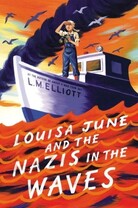 Louisa June and the Nazis in the Waves. L. M. Elliott. (2022). Katherine Tegen. At the end of 1941, 13-year-old Louisa June’s Tidewater Virginia family know of the presence of German U-boats and the sinking of ships off the east coast. Kate is working as a riveter at the Newport News shipyard; Will is a merchant marine; Joe has joined the navy; and Butler is working on their father’s tugboat before heading off to college in the fall. When the tugboat is torpedoed, killing Butler and severely injuring her father, the family struggles to deal with the loss of Butler and to find income. Learning the government is considering forming a Civilian Picket Patrol, Louisa June wants to help protect the coast. With her friend Emmett, she takes the family boat to an observation post, only to find they are a target for U.S. pilots in training. The back matter for this engaging middle grade novel depicting the early days of World War II on the home front includes information on the historical events that figure in the novel, separating fact from fiction. (Gr 3 Up)  Love in the Library. Maggie Tokuda-Hall. Illus. by Yas Imamura. (2022). Candlewick. In this beautifully crafted picture book, Maggie Tokuda-Hall tells the story of her Japanese American grandparents’ incarceration at Minidoka Relocation Center in southern Idaho during World War II. Harsh weather, lack of privacy, and uncertainty about whether she will ever be free are constants in the life of Tama, the librarian at Minidoka. As she shares her love of books and feelings with George, who visits the library every day, they fall in love. They marry, their first son is born, and they hope for the best. In thinking about these events happening in the internment camp, Tama writes in her journal, “The miracle is in us as long as we believe in change, in beauty, in hope.” In her author’s note, Tokuda-Hall provides a context for the story and shares thoughts on how racism, which led to the incarceration of people of Japanese ancestry during World War II, remains a problem in the U.S. today. (PreK Up)  The Lucky Ones. Linda Williams Jackson. (2022). Candlewick. In 1967, Black 11-year-old Ellis Earl Brown, who cares for seven siblings and four cousins while his mother finds work outside their home on the Mississippi Delta, has dreams of becoming a teacher or a lawyer, like Thurgood Marshall. Ellis Earl loves school and admires his teacher, Mr. Foster, who encourages Ellis Earl to learn, lends him books, and often feeds him. Mr. Foster gives him Roald Dahl’s Charlie and the Chocolate Factory, which he loves, and the opportunity to participate in activities at the AME Church. During a field trip to Jackson to meet Senator Robert Kennedy, who is visiting the area on his “poverty tour,” the children witness the virulent racism that undercut national integration laws in the 1960s. The back matter for this novel of self-discovery includes information about the lives of the people living on the Delta and Senator Kennedy’s 1967 visit to the area. (Gr 3 Up) 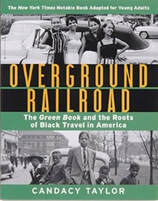 Overground Railroad: The Green Book and the Roots of Black Travel in America. (Young Adult Adaptation). Candacy Taylor. (2022). Amulet. This young adult adaptation of Overground Railroad (2020) gives readers an engaging road trip-view of 20th century American history through the pages of The Green Book, the annual guide for Black travelers published from 1936 to1966. Victor Hugo Green (1892-1960), a Harlem mail carrier for decades, created The Negro Motorist Green Book as a guide to safe travel. Over the years, the book included more and more businesses, restaurants, accommodations, gas stations, and other facilities open to Black travelers as they became part of the American economy, building prosperity and mobility in the face of ongoing discrimination and segregation. Candacy Taylor’s lively narrative also offers accounts of key travel-related events such as the development of the interstate highway system, the evolution of rail travel, and the migrations from south to north and east to west. Overground Railroad includes many archival photographs and images from The Green Book, an extensive epilogue, source notes, a bibliography, and an index. (Gr 6 Up) 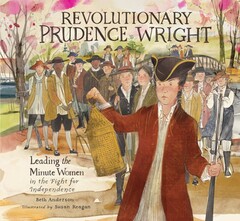 Revolutionary Prudence Wright: Leading the Minute Women in the Fight for Independence. Beth Anderson. Illus. by Susan Reagan. (2022). Calkins Creek. Growing up in colonial America, Prudence Cummings argued with her brothers against the rule of King George III. “Prudence had a spark of independence.” After she married David Wright of Pepperell, Massachusetts, in 1761, she was eager to join the fight for independence. Thinking about the quilts she helped make with small pieces of cloth, Prudence realized that small actions might form a pattern of rebellion. The expressive watercolor and digitally-drawn illustrations of this biography of Prudence Cummings Wright (1740-1824) depict the arming of town militias, the minutemen, and the division in her family with brothers being Tories (Loyalists), one even a spy, while her husband was a Patriot. As conflicts accelerate, the women strategize a way to defend the town, and Prudence becomes the leader of the first unit of minute women. Back matter includes an afterword, author research notes, illustrator’s notes, and a bibliography. (PreK Up) 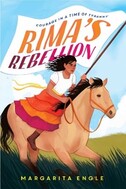 Rima’s Rebellion: Courage in a Time of Tyranny. Margarita Engle. (2022). Atheneum. In 1923, 12-year-old Rima Marín lives with her Abuela and Mamá in Cuba, working as blacksmiths and lacemakers and living as squatters on her father’s land. As an illegitimate child, una niña natural, Rima has no legal rights and is shamed. Years before, Rima’s grandmother founded the Mambisa Voting Club during the time of mounting discontent under the Machado regime. Seeing the contrast between her life and that of her half-sister, Violeta (who has privilege, wealth, and comfort), and her growing awareness of the strength and resourcefulness of the Mambisas and her own abilities inspire Rima to become involved in the fight for the rights of women. Spanning 13 years, Margarita Engle’s novel in verse reveals the complex ethnic and racial history of Cuba. Back matter includes an historical note and an international timeline of women’s suffrage (Cuban women were granted suffrage in 1934). (Gr 6 Up) 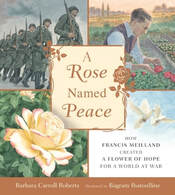 A Rose Named Peace: How Francis Meilland Created a Flower of Hope for a World at War. Barbara Carroll Roberts. Illus. by Bagram Ibatoulline. (2020). Candlewick. At the age of 17, after visiting a rose grower who cross-pollinated rosebushes, Francis Meilland (1912-1958) began experimenting with hybridization of roses on his family’s farm in southern France. In June of 1939, after years of experimentation, he revealed to rose enthusiasts a large rose with petals that were shaded from ivory to yellow and tinged with pink on the edges. Just before the German invasion of France, Francis mailed cuttings of the rose to a few growers including Robert Pyle in the United States. Bagram Ibatoulline’s stunning watercolor paintings dramatically depict the Meilland family’s burning of acres of rosebushes in order to cultivate vegetables. When the war is over in 1945, Francis receives a letter from Robert Pyle about his naming of the rose Peace. Back matter includes an afterword, a glossary, and references. (PreK Up)  This Rebel Heart. Katherine Locke. (2022). Knopf. In 1956 Communist-governed Budapest, 18-year-old Csilla Tisza and her aunt, who are the only members of her Jewish family to survive the Holocaust, are wary of the government’s antisemitism. Although she has been quietly doing her job as a typist and living a life that goes unnoticed while she plans her escape from Hungary with her aunt, friends encourage her to meet Tamas and other university students, and she becomes involved in the growing unrest that leads to the student uprising that began the Hungarian Revolution of 1956. The novel’s magical element of the Danube whispering to her and a friendship with Azriel, the angel of death who becomes involved in the resistance, contribute to Csilla’s growing courage to rebel. Each chapter begins with an excerpt from her father’s journals from 1945 that show his hopes for the family’s future. Information on the student uprising of 1956 in Budapest is included in the back matter. (Gr 9-12) 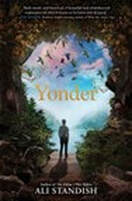 Yonder. Ali Standish. (2022). Harper. In 1943, the narrator of this story, 13-year-old Danny Timmons, is determined to solve the mystery of the sudden disappearance of Jack Bailey, who became a local hero when he saved twins during the Great Flood of 1940 as adults looked on and did nothing. Flashbacks to events during the past three years weave together a history of disturbing events of bullying, prejudice, and injustice in the community of Foggy Gap, North Carolina, and the story of Danny’s growing friendship with Jack, who is abused by his father, a troubled World War I hero. Jack is the one who introduces Danny to Yonder, a magical place free of all worldly ills that Jack longs to travel to one day. This coming-of-age mystery is a thought-provoking story of friendship and having the courage to stand up against evil on the home front in the early days of World War II. Back matter includes historical notes and discussion questions for the classroom. (Gr 6 Up) Sandip Wilson serves as professor in the School of Education and English Department at Husson University, in Bangor, Maine, and is President-elect of the Children’s Literature and Reading Special Interest Group.
|
AuthorsThese reviews are submitted by members of the International Literacy Association's Children's Literature and Reading Special Interest Group (CL/R SIG). Archives
May 2024
Categories
|

 RSS Feed
RSS Feed